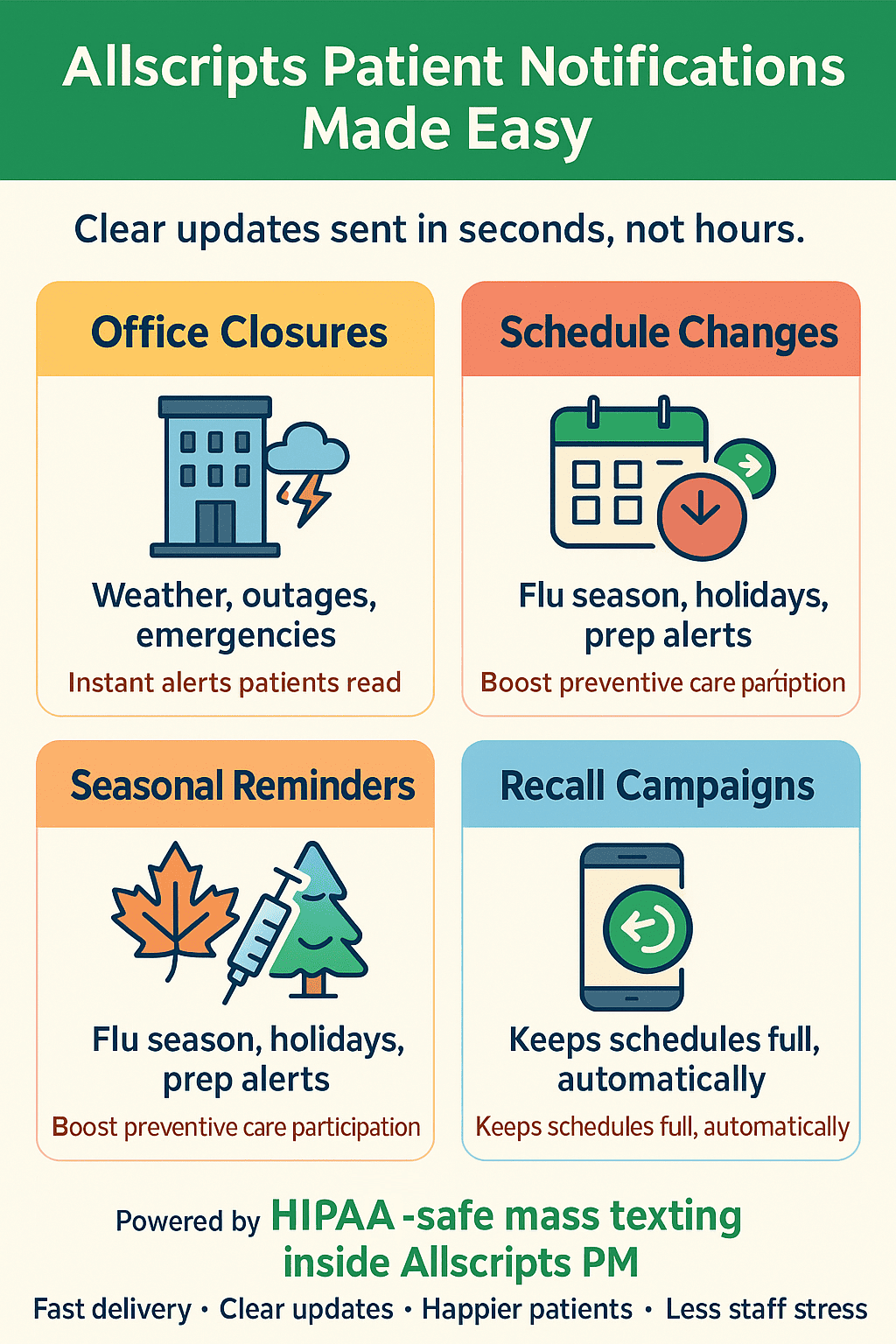Streamlining Patient Notifications with Mass Texting in DrChrono
💡 Patient notifications in DrChrono become easier when you use secure mass texting. By integrating mass texts into your workflow, you can: Send...
10 min read
Gregory Vic Dela Cruz : Nov 20, 2025 8:00:02 AM

Share office closures in minutes.
Send weather or power outage alerts by text.
Update patients about location changes or modified hours.
Run recall campaigns without hundreds of phone calls.
Use broadcast alerts Allscripts to reach the right groups.
Reduce stress for your team when schedules shift.
Patients know if your office is closed, when you will reopen, and what to do next. Curogram simplifies broadcast messages for your own organization through compliant automation.
Imagine a storm moving in faster than expected. You look at the schedule and see a full day of patients who may not be able to reach your office. Without a simple way to send Allscripts patient notifications, you are left with one painful option. Your team starts calling each person and hopes they answer in time.
You know how that story goes. Some patients miss the call. Some never listen to voicemail. Others show up anyway and feel upset or confused. Your staff is exhausted from hours on the phone. You still end up with people standing at a dark door, wondering what happened. That feeling is hard on everyone.
Mass texting in Allscripts PM gives you a different path. Instead of dialing number after number, you send one clear message to everyone who needs it. You can use broadcast alerts Allscripts for closures, urgent updates, and even seasonal recall campaigns when you want patients to come back in.
In this article, you will walk through the challenges of life without mass texting, see how Curogram can simplify broadcast messaging, explore the benefits for staff and patients, review a real-world use case, and finish with concrete next steps you can follow.
In our ultimate guide, we tackled the urgent importance of mass texting in AllScripts PM. Because when you do not have a way to send fast, wide-reaching Allscripts patient notifications, simple changes can turn into all-day problems.
A single weather event, power outage, or building issue can throw your schedule into chaos. You rely on phones and voicemails that do not always reach people in time. Your team feels the stress of trying to do the right thing with tools that are too slow.
Without mass texting, the first step is usually a printed list. Your staff divides names and starts calling each patient. They leave messages, write notes, and check off who they reached. It is careful, honest work, but it takes a lot of time. While they are making calls, other tasks get delayed.
Many of those calls will not connect. Some patients do not answer unknown numbers. Others are at work or driving and cannot pick up. This means your team has to try again or hope people listen to voicemail quickly. You end up putting in a lot of effort without knowing who really got the message.
When updates do not reach people, you see the impact right away. Patients still arrive at a closed office. They bring children with them or take time off work for an appointment that no longer exists. They feel confused, frustrated, and sometimes worried that they missed something important.
From your side, you feel bad because you tried. You did the calls and the voicemails, but the gap between you and your patients is still there. That gap can break trust over time. People start to wonder if communication will be this hard every time something changes.
The people at your front desk and in your call center carry a heavy load during disruptions. They hear the worry in every voice. They listen to stories about missed work, child care, and long drives. They want to help, but the volume of calls and the slow tools make the work feel endless.
After a day like that, your staff is drained. They still have regular tasks waiting for them, such as messages, paperwork, and coordination with providers. It is easy for burnout to grow when every unexpected event turns into a scramble. Without mass texting, you do not have a simple way to take some of that pressure off the people who support your patients every day.
When you add Curogram on top of Allscripts PM, your communication during disruptions becomes more structured. You do not lose the ability to call patients when needed. Instead, you gain a faster, broader option for updates that affect many people at once. This is where Allscripts patient notifications can really help you stay in control.
In stressful moments, it is hard to write a clear message from scratch. With Curogram, you can build text templates in calmer times. These templates cover common situations like office closures, provider schedule changes, or simple health alerts. When you need them, they are ready with the right wording.
You can customize each template with details such as date, time, and location. This keeps your broadcast alerts Allscripts messages consistent and easy to understand. Patients receive clear instructions about what is happening and what they should do. Your staff does not have to invent new language every time something changes.
Instead of dialing numbers one by one, you select the group that needs to hear from you and send one message. The system uses the contact information already connected to Allscripts PM. In a few moments, hundreds or thousands of people receive your update. This is a very different feeling from staring at a long call list.
You can filter groups based on location, provider, appointment type, or date range. For example, you might send a closure update only to patients scheduled on a particular day. Or you might send a reminder for flu shots to a certain age group as part of regular recall campaigns. The control stays with you, but the heavy lifting is handled by the system.
One advantage of mass texting is that you can see which messages were delivered. You no longer guess whether a voicemail was heard. Delivery information gives you a quick sense of how many patients received your notice. You can then decide who needs a follow-up call or a different type of outreach.
This kind of tracking helps you use your team’s time better. Instead of calling every single person, you focus on smaller groups who did not receive or respond to the text. The work becomes more targeted and less overwhelming. Your team spends their energy where it has the most practical impact for patients.

When you bring mass texting into your Allscripts patient notifications strategy, you are not just adding a new tool. You are changing how people experience sudden changes and group updates. Patients feel more informed. Your team feels less pressure. The whole system becomes calmer and more predictable on difficult days.
In an emergency, speed matters. With mass texting, you can reach many patients in minutes instead of hours. People find out about closures or safety issues while there is still time to change plans. That quick notice can prevent confusion in the parking lot and stress in your waiting room.
One of the hardest moments is seeing patients arrive at a closed office. They may feel angry, worried, or embarrassed. Broadcast alerts Allscripts can give them a clear message before they leave home. When they know about changes in advance, they can adjust without feeling blindsided.
Every closure or major update used to mean hours of calling. With mass texting, one message replaces many of those calls. Your staff can use that time to manage the schedule, handle exceptions, and support patients with complex needs. Their day feels more manageable, even when plans shift.
Templates help you say the same thing in the same way to everyone who is affected. There is less risk of one person hearing a different version of events than another. Patients share the same core information with family members and caregivers. This consistency helps protect trust in your practice during stressful situations.
When your team is not stuck making repetitive calls, they can focus on higher-level tasks. They can help reschedule complex cases, answer detailed questions, and support your providers. People feel more like professionals and less like call center agents. That shift can improve morale across your offices.
If you have multiple sites, coordinating communication can be complicated. Mass texting lets you target messages to specific locations or send a unified message across all sites. Everyone hears the same update at nearly the same time. This makes your organization feel more connected and organized.
Beyond closures, you can use the same tools for recall campaigns. For example, you can send reminders about flu vaccines, annual physicals, or screenings. Patients receive gentle nudges that help them stay on track with their care. This supports your clinical goals without adding heavy phone work.
Many of your patients juggle jobs, children, and other responsibilities. They may not be able to answer calls during the day. Text updates give them information in a format they can read when they have a quiet moment. This respects their time and reduces the feeling that healthcare always interrupts their life.
When you reschedule groups of patients, mass texting helps them arrive better prepared. You can include new dates, times, and short instructions in the message. Patients know what to expect and what to bring. That preparation helps the new schedule run more smoothly.
Call centers do not disappear, but their workload becomes more steady. Instead of huge spikes on days with sudden changes, volume spreads out more evenly. Staff can give more attention to each caller. The work feels less like constant crisis management and more like steady support.
With mass texting tied to Allscripts patient notifications, you have a record of what was sent and when. This can be helpful for internal reviews or quality projects. You can show that you made a good-faith effort to inform patients. Having that documentation reduces uncertainty when questions come up later.
Phone calls can lead to misunderstandings, especially when people are stressed. Text messages provide written information that patients can reread. They can share the message with family members who help them manage care. This lowers the risk that someone misremembers details about closures or schedule changes.
Some patients face extra barriers, such as limited transportation or fixed work schedules. When they receive reliable updates, they can make better choices about when to travel and when to stay home. This is especially important in bad weather or community emergencies. You help protect them from unnecessary strain.
Not every situation can be handled with a text. Some patients need long conversations or detailed support. By using mass texting for broad updates, you free time to focus on those complex cases. Your team can give them the attention they deserve instead of rushing to clear a call queue.
Over time, your practice starts to feel different. You know you have a plan for closures and group updates. Your staff trusts that they will not have to handle every shift with only phone calls. Patients learn that you will keep them informed in a clear and timely way.
All of these benefits come from building a more intentional approach to Allscripts patient notifications. You are still the same practice with the same values. You simply have better tools to show patients that you respect their time and their need for information. That can change the emotional tone of your work in a very real way.
Picture a large group practice with several clinics in the same region. A winter storm is forecast to hit overnight, and the roads will be unsafe the next morning. In the past, this group would stay late printing lists and preparing for hours of phone calls. Staff would come in early to start dialing, knowing they could never reach everyone before the storm arrived.
After setting up mass texting for Allscripts patient notifications, they try a different approach. The night before, they use a closure template and filter for all patients scheduled the next day. In a few minutes, about 3,000 patients receive a simple text that explains the closure and offers a link or phone number to reschedule. The next morning, phone lines are busy but not flooded, and far fewer people arrive at closed doors.
Staff report feeling more in control. Providers know their patients were informed ahead of time. The practice still has work to do, but the work feels possible. This use case shows how one change can protect both patients and staff when weather or other disruptions hit without warning.
First, pick one type of situation that causes the most stress, such as weather closures or last-minute provider cancellations. Then, draft a simple template that explains what is happening, who is affected, and how patients can reschedule or learn more. Work with your team to decide which patients should receive the message and how far in advance you will send it. Start with a small test group if that feels safer.
After you send your first broadcast, watch what happens. Notice how many calls you still receive and how patients talk about the update. Ask your staff what felt easier and what could be improved. With each round, you can refine your templates, timing, and filters. Over time, mass texting becomes a natural part of how you handle closures, updates, and even recall campaigns that support long term care.
You want tools that fit into your real world, not ideas that live only on a whiteboard. Curogram is designed to integrate with Allscripts PM and support the way you already schedule and document visits. Instead of replacing your systems, it connects to them and adds structured messaging on top. That connection is what makes Allscripts patient notifications by text feel so natural.
With Curogram, you can build templates, choose patient groups, and send broadcast messages from a shared workspace. Your team sees what was sent, who received it, and which situations may still need a phone call. You keep control of your own policies about cancellations, closures, and reminders. The platform simply gives you a faster, more reliable way to carry out those decisions.
Most important, Curogram helps you support both staff and patients in the moments that feel most fragile. A storm, a power issue, or a building problem does not have to turn into a communication crisis. You have a clear process for getting the right words to the right people at the right time. That sense of readiness can lessen the emotional load on your team and show patients that you are looking out for them.
Office closures and sudden updates will always be part of healthcare. Buildings flood, storms roll in, and schedules change. What you can control is how you communicate in those moments. With mass texting in Allscripts PM, you give yourself a stronger way to send clear, timely Allscripts patient notifications when they matter most.
Instead of long call lists and uncertain voicemails, you send simple messages that reach many people at once. Patients feel more informed and less confused. Your staff feels less like they are fighting a losing battle against the clock. The entire experience of a “bad day” becomes more manageable for everyone involved.
As you learn what works, you can expand your use of broadcast alerts in Allscripts and even build thoughtful recall campaigns for preventive care. Step by step, you can move toward a workflow where important news reaches patients quickly and your team has the space to respond with calm and care. Curogram can help get you there faster.
Want to see how easy it is to set up mass texting for your practice? Book a quick demo today.

💡 Patient notifications in DrChrono become easier when you use secure mass texting. By integrating mass texts into your workflow, you can: Send...

💡 Mass texting in Office Ally helps you send patient notifications without overloading staff. By integrating mass texting to your EMR, you can: ...

💡 Radiology patient notifications in Exa are complicated with phone calls and scattered emails. But through patient notifications in Exa radiology...